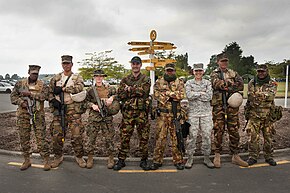This article needs additional citations for verification. (November 2011) |

| Part of a series on |
| Western dress codes and corresponding attires |
|---|
|
Legend:
|
A combat uniform, also called field uniform, battledress or military fatigues, is a casual type of uniform used by military, police, fire and other public uniformed services for everyday fieldwork and combat duty purposes, as opposed to dress uniforms worn in functions and parades. It generally consists of a jacket, trousers and shirt or T-shirt, all cut to be looser and more comfortable than more formal uniforms. Design may depend on regiment or service branch, e.g. army, navy, air force, marines, etc. In the army branches, fabrics tend to come in camouflage, disruptive pattern or else green, brown or khaki monochrome, in order to approximate the background and make the soldier less visible in nature. In Western dress codes, field uniform is considered equivalent to civilian casual wear. As such, field uniform is considered less formal than service dress uniform, generally aimed at office or staff use, as well as mess dress uniform, and full dress uniform.
The British Indian Army in the mid 19th century were the first to use drab cotton uniforms for battle;[1][2] they were first worn by the Corps of Guides in 1848 where the colour of drab light-brown uniform was called khaki by Indian troops. The first purpose-made and widely issued contemporary military camouflage fabric was for half-shelters by the Italian Army after the First World War. Germany was the first to use such shelter fabric for uniforms for their paratroopers, and by the war's end both various German as well as the older Italian fabric was widely used for camouflage uniforms.[3] Most nations developed camouflage uniforms during the Second World War, initially only issued to "elite" units and then gradually to all armed forces.
- ^ "Khaki Uniform 1848-49: First Introduction by Lumsden and Hodson". Journal of the Society for Army Historical Research. 82 (Winter): 341–347. 2004.
- ^ Barthorp, Michael (1988). The British Army on Campaign 1816–1902: Volume 3 (1856–1881). Osprey. pp. 24–37. ISBN 0-85045-835-8.
- ^ Borsarello, J.F. (1999). Camouflage uniforms of European and NATO armies : 1945 to the present (1.udg. ed.). Atglen, PA: Schiffer Pub. ISBN 0764310186.